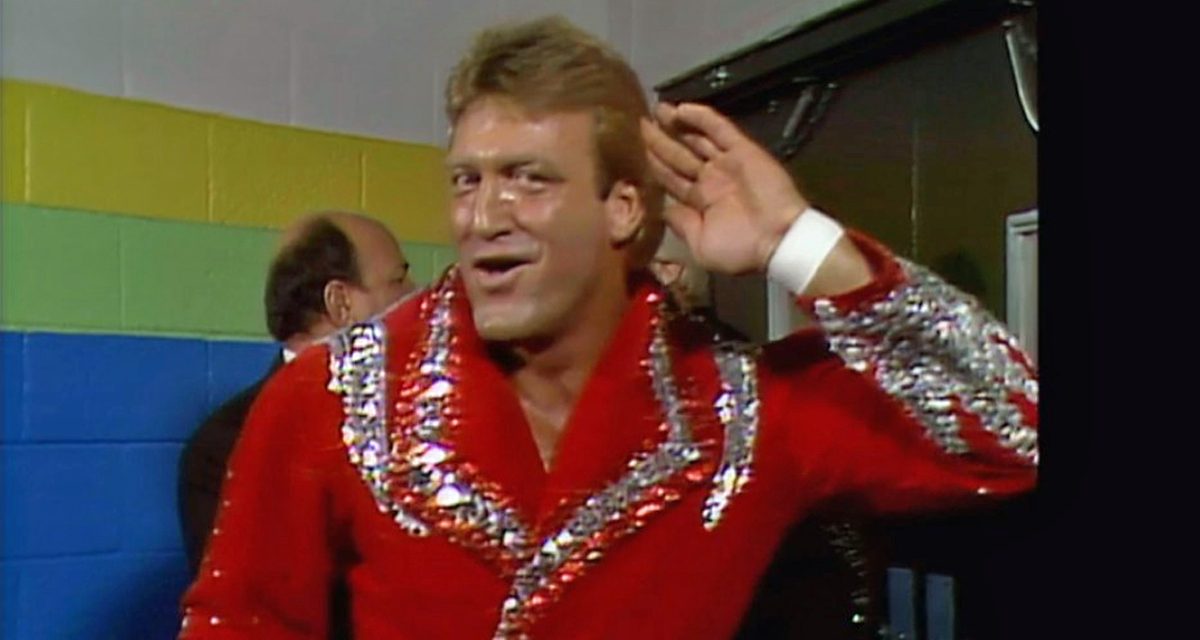Back in the day, some wrestlers were more style than substance.
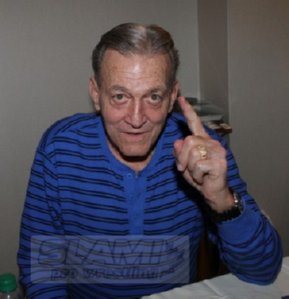
Paul Orndorff in early March 2016. Photo by George Tahinos.
Paul “Mr. Wonderful” Orndorff had both, earning his legendary reputation as a true toughman in professional wrestling with his rock solid body, fierce intensity, and revolutionary style in the ring.
That’s why the former college football star, streetfighter, and wrestling Hall of Famer is being honoured with the Men’s Wrestling Award at the upcoming Cauliflower Alley Club’s 51st Reunion, April 11-13, in Las Vegas, Nevada.
Paving the way for some of the greatest main events in pay-per-view history, Paul Orndorff teamed with Rowdy Roddy Piper to take on the team of Hulk Hogan and Mr. T in the first ever WrestleMania.
Before arriving in the WWE in 1983, Orndorff honed his craft throughout the NWA, feuding with the likes of “Mad Dog” Buzz Sawyer, Ted DiBiase, Junkyard Dog, and Dick Murdoch, winning numerous titles and challenging the world heavyweight champion, Ric Flair.
His unforgettable rivalry against Hulk Hogan in WWE was highlighted by their title bout at “The Big Event” in Toronto in front of 70,000 fans, and their controversial steel cage match on Saturday Night’s Main Event is still talked about today.
As his in-ring career began to wind down, Orndorff helped mold a new generation of promising stars at WCW’s Power Plant.
In celebration of Orndorff’s Men’s Wrestling Award, and the 40th anniversary of his 1976 debut in Memphis, SLAM! Wrestling recently caught up with “Mr. Wonderful” for an in-depth chat about his career, his piledriver, believability, Roddy Piper, Bobby Heenan, and his perspective on the art of wrestling.
* * *
SLAM! Wrestling: Congratulations on being honoured with the prestigious Men’s Wrestling Award at the upcoming CAC Reunion.
Paul Orndorff: You know, I was the type of person that the good Lord gave me the ability to do sports, whatever it was, and I told myself that when I got into this wrestling and everything, that I was gonna be one of the best if not the best.
And that’s the way I kept myself going, because the better you are, the more money you make and that’s what drove me. Because I had the ability. Here, you got a football player in the wrestling game, and I just was gifted and I could do it. In that ring, I could change my mind and in a second I could do something else, and I don’t see that anymore. And that’s why there’s hardly no more wrestling. So, I don’t know if that makes sense to you but that’s the way I did it.
SLAM! Wrestling: Your style was always very intense.
Paul Orndorff: Yes it was, because there’s a different crowd every night. Those people paid good money to watch a wrestling match. And I was always told, Eddie Graham told me and Hiro Matsuda, they told me when you get in the ring you give people their money’s worth. And I tried to do that every night.
And that’s what I did, it’s something you just don’t do, you got to think about it. And I tried to do that every night, and I mean this, I tried to give the fans a good match, no matter who it’s with, no matter what. I would find a way to make those people either love me — though I didn’t really care — or hate me. And that’s what I liked, ’cause I could do that the best.
It’s that way with my wife, my wife loves me but she hates me (laughs).
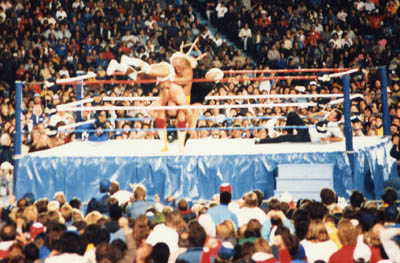
Hulk Hogan goes to piledrive Paul Orndorff at The Big Event in Toronto, and Bobby Heenan attacks him with a chair to the back. – photo by Bill Cubitt.
SLAM! Wrestling: Can you shed some light on establishing your character when you started out wrestling in Mid-Southern Wrestling?
Paul Orndorff: In my eyes, I had to be different than everybody else and the only way you can do that is with the attitude you have, the body you have, and the energy you have. And I had it.
And I didn’t see anybody else that had that kind of energy or body or that aggressiveness that I had. And that’s what got me over. They saw it, the people knew this was something different and I just kept doing it every night, night after night, 300 days a year. I’d do it no matter what. I’d figure out a way to do it and that’s what you have to do if you love what you do, you really do.
SLAM! Wrestling: As a heel, you came across as a very believable, mean-spirited pugnacious bully. How much of that character was drawn from your personal life?
Paul Orndorff: I was exactly that way in high school, because that’s the way I was. I had issues. I did. We all do, but my issues were pretty bad if you want to know the truth.
You know, when your family just disintegrates and you are left out there by yourself, basically, you do what you have to do. And thank God that I had the right people to support me. I had the right coaches in high school and junior high, then in college, that kept me on track. And that’s what happened, I had so much respect for the coaches, because they’re the ones that kept me from being in prison or doing something really bad. They didn’t give up on me and they hung with me. I had the right people in my corner.
And there’s so many kids out there today, some of them are being helped but a lot of them don’t get the help, because there’s just so many of them. Times are so tough now for these kids. And for me, a way for me to do that was to be in sports, and I just had the right teachers and the right coaches. And believe me, I had a bad attitude, but with the right people helping you, you can overcome it and I did. And like you said, I even found a way to use it as a positive.
SLAM! Wrestling: Like your belligerent character, everything you did in the ring was brutally believable, especially the way you delivered a kick.
Paul Orndorff: I wanted to be different than anybody else, so when I kicked, I didn’t make it look like a simple kick, I made it look like I was going to take the guy’s damn head off.
And it takes time and everything to hone your craft and style in the ring. Because when I started in it, they didn’t have bodies like the body I had and they didn’t have the energy like the energy level I brought to the ring, and I was kind of in this whole new era back then. And you know, I did it my way and it paid off. It was hard though, y’know, I broke my neck three times and kept on wrestling. That’s the sad part of it, I’d get surgery and get rods, and nuts and bolts all put in my neck, and then I’d still go out and do it all again like an idiot. But that’s how much I loved it, though. I loved it.
SLAM! Wrestling: Along with your physique, it didn’t hurt that you had a face that looked like it was chiseled out of stone…
Paul Orndorff: (laughs) That’s right. That was everything. If I had had this babyface-looking face where I couldn’t have conveyed the arrogance and attitude, it wouldn’t have worked.
SLAM! Wrestling: By the late ’70s and early ’80s, you were splitting your time between Southeast Championship Wrestling, Mid-South, and Georgia. What was it like working in those established territories?
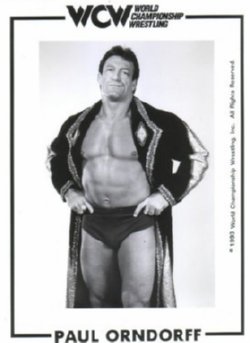
Paul Orndorff in a WCW publicity shot in 1993.
Paul Orndorff: I had to overcome a lot, to tell you the truth, because wrestling had been around for a long time. So here you had this young guy that was just starting out, and who was a little dangerous in the things he did. And a lot of the older guys were set in their ways, and I couldn’t blame them because if you get hurt in the wrestling business, you’re out of luck because they don’t pay you if you get hurt. So you had to try to wrestle every night where you didn’t hurt nobody, but make it look like you did. And I did that, I finally mastered it but it took me a while, and a lot of the older guys did help me, but most of them didn’t.
And the reason why, was because I was taking their money. But you know something, let me tell you how that is, that made me even better. I’m glad they didn’t help me, and I did it my way. Because their way was old. It was done. We had a whole new group of people, we had a whole new group of athletes, and we were bigger, faster, stronger, quicker.
So I put it all together, and I had to work at it. I had to think about it. People would think, ah it’s easy and all that, but it wasn’t easy. And I’d use my brain every night. I’d stay up just thinking about if I should of done this instead of that, and I should have done that instead of this. And then finally I took all the good and threw away all the bad, and then I started really working on the good and that became my style. So my energy level, the way I looked, how I acted, the attitude I had, the way I could talk, the whole thing. And it really did work because nobody had ever seen it that way before.
SLAM! Wrestling: Did you see yourself as a revolutionary artist?
Paul Orndorff: Absolutely. I would say I was, who’s that real famous artist?
SLAM! Wrestling: Leonardo Da Vinci, Michalangelo, Van Gogh, Picasso?
Paul Orndorff: I was all of them in one (laughs). I was! I took it so serious and I wanted to be so different than everybody else, and that’s what was going on in wrestling back when I first broke in, that old, old, old style. And it was old. And I’d like to think that I was the beginning of the new. And I know I was, I know it because nobody else could hang with me, when it came right down to it. In a match, I could stay as good for one hour as I could for 10 or 15 minutes.
SLAM! Wrestling: Your piledriver was one of the most devastating of all time. Tell us how you developed your famous finisher.
Paul Orndorff: At that time, everybody did a piledriver that same old way. And back then, I would squat 500-600 pounds. I could squat 600 pounds and do reps with it, and that is the truth. So I thought, if I could do that, then I’ve got the legs to jump up and come off of the ground. And so you’ve got me with my legs straight out and my opponent between my legs, and when I hit he shoots up about four, five, six, eight inches. And I went, wow, I just came up with it.
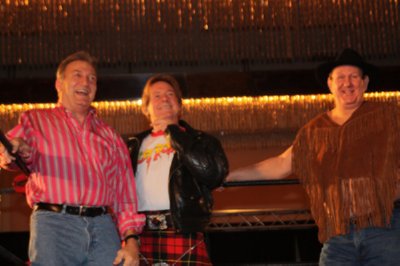
“Rowdy” Roddy Piper, “Cowboy” Bob Orton and “Mr. Wonderful” Paul Orndorff relive old times on a set for Piper’s Pit at WrestleReunion in January 2011. Photo by Christine Coons.
See, really, the fact is I’m a genius in many ways when it came to wrestling back then, because I came up with these things that nobody else did, like my piledriver, which was unique. Nobody helped you back then too much.
I know that, wrestling is what it is, but I wanted to take it two more levels ahead and make it look so damn real. And when they believe in you like that, guess what, the stadiums starts fillin’ up.
SLAM! Wrestling: Speaking of packed stadiums, tell us about wrestling Hulk Hogan at Toronto’s Exhibition Stadium in front of a record crowd of 70,000 in the summer of ’86, hailed as “The Big Event.”
Paul Orndorff: Wasn’t that something? That was unbelievable, wasn’t it? Well, I thought, damn, I’m gonna make some money this night and I’m going to give those people their money’s worth and then some. Now, if Hogan can’t, well that’s his problem because I’m going to give what I wanted to do. And I knew how to do it and I knew that I needed to make him look good, and I damn sure was gonna look good. And I did, I did just that.
SLAM! Wrestling: You had many memorable matches in Toronto’s Maple Leaf Gardens as well when you first arrived in WWE, against fan favourites like of Rocky Johnson, Tony Atlas, and Tito Santana.
Paul Orndorff: Maple Leaf Gardens, I loved it there, man. I mean, that was the best in my opinion. Those people, I can remember, getting out of my cab and there would be about a thousand people waiting and they’d be raising hell, throwing things at me and cussin’ me out. And it got to the point where the police car had to take me from my hotel and take me into the building, the police did. The fans, they’d throw batteries and eggs and crap thrown at me and bottles. But those fans in Toronto especially hated my guts and I loved it. And believe me, I was thankful for that big ramp they had there that led to the ring.
SLAM! Wrestling: Your believability and in-ring style also resonated with Japanese fans as you did several tours for New Japan Pro Wrestling.
Paul Orndorff: I was a hardcore kind of wrestling guy, and if you want to wrestle I can wrestle ya. And that was the attitude I had, y’know. And I did very well over there. I was over there five or six times and the people over there, when they’d see somebody like me doing some of the stuff I did, they would clap their hands and everything. And that’s how they expressed that they hated you, and they respected your ability. I wrestled (Antonio) Inoki and (Seiji) Sakaguchi, along with Kengo Kimura, (Riki) Choshu, and (Akira) Maeda. You know, working with Hiro Matsuda, yeah all those guys, and I could hold my own with them, I can tell you that much.
SLAM! Wrestling: The Heenan Family wouldn’t have been the same without the tumultuous relationship you had with Bobby Heenan. What did “The Brain” bring to the development of your character in WWE?
Paul Orndorff: Bobby Heenan, he was the best. Bobby took me to another level. When it came to getting in the ring and wrestling, Bobby Heenan was the Paul Orndorff, he was like me in the ring except he was that way as a manager. And the way he talked and his attitude, I loved the guy man, he helped me so much and took me to another level and the way he talked. And the way he offered advice, he’d always say to me, “Paul, if you say you’re going to kick a guy between the legs as hard as you can, then you got to do it too him.” And I started doing that, everything I said, I did. And when I said I was going to take somebody and bloody their nose, guaranteed you’d see a bloodied nose. Bobby taught me that.
It’s like a movie, it’s like the shows on TV, every weekly show, NCIS, I watch that, and they have to do something different every week that keeps you coming back for the next show. And that’s exactly what I tried to do. To honestly do something that the fans would remember so they would come back the following week or the following month to see if I was gonna do what I said I was gonna do, and do it to that person. And it hooks the fans if you do it right.
SLAM! Wrestling: WWE Network has recently been airing that Table for 3 episode you filmed with Mean Gene Okerlund and Roddy Piper, who passed away not long after.
Paul Orndorff: Roddy Piper, he was a friend, man. This guy, he didn’t have the best body or this or that, but he had the best talk there ever was.
And he had a way of doing things in the ring that the fans loved to hear him talk so much and they’d come to just hear him talk and do what he said he was gonna do, and he did. Roddy was a really good friend, I mean, he was my buddy, man. And I used a lot of his stuff, the way he did it, you always got to take a little bit from this guy and from that guy, and then this guy and that guy over there, and then add it all together and I kind of did that with Roddy, because he was the best talker in my opinion, in the business.
The way he talked and the way he did it, like nobody else. The people believed in him, and I loved him and I respected him and he was my friend. Roddy did the talkin’ and I did all the other stuff and it worked so good. I mean Roddy could out talk anybody so I did my thing with a little bit of talk too, but primarily I did my thing, which was the physical thing. So you had his talkin’ and my body. There will never be another Roddy Piper. I just don’t see it. He passed away about six months later. I got a phone call and it broke my heart, man.
SLAM! Wrestling: Your ring gear from that era in the WWE is instantly recognizable, from your signature boots and trunks to your colourful robes. Have you kept any as a keepsake?
Paul Orndorff: Yes, I do have a robe and a pair of boots and a couple pair of trunks, they’re around the house somewhere. I gave one of my robes to the Professional Wrestling Hall of Fame, and then the other ones I gave to my son and my grandsons. I had about five or six of them, and I still got a couple left, I think, I’d have to look. (long pause)
You know, I just wish I could never get old because I had such a good time. And the people, back then the people, those people I did what I did because of the people, and I don’t know if that makes sense, but what I mean is, if they wanted more then they got it with me. And I truly believe that. They got what they wanted and that’s why it worked because they were tired of, you know it was a whole new era, and they needed somebody out there to do something that was different. And the Hulkster did that and Roddy Piper did that, and I did that, and Tito Santana did that, we all were different in different ways. And that’s why people loved the wrestling back then. That’s why you loved it. I can tell you loved it.
You know, my memory, it’s not so good. I had cancer and that chemo and radiation, and it takes a toll on you.
But I can remember this, I was at my father-in-law’s house, this was in high school, and my wife, I was over there and he turned on the TV. His name was Ralph Maxwell, he turned on the TV and wrestling was on and I watched it. I never really watched it before, because the way it was, it wasn’t real to me. I was all about football and street fighting. And wrestling, I just didn’t get it.
But I started watching it, and every Saturday, my father-in-law and Eddie Graham and Hiro Matsuda, they would be on TV and I got to thinking about that, and I said, “You know, Ralph, I could do that.” And he said, “You want to meet Eddie Graham? You want to talk to him?” And I said, “Hell yeah!” Did you know that my father-in-law Ralph Maxwell, he got in touch with them, and he got Hiro Matsuda and Eddie Graham and Mike Graham, and I had a pretty big name in Tampa, Florida because of my football, and I was a street fighter back then too.
I mean, back then we had little things where people would bet on you and you’d go at it. We’d fight. You know what I’m talking about? Well, I’m telling you we did, and that’s the truth. I used to work for a big company and that company, I was kind of their guy, so when our company would go against another company and it was a street fight, and people would bet on it. Now, people think I’m crazy, and I am! And I’m telling you the God’s honest truth. That was my attitude and that’s what I was all about.
SLAM! Wrestling: How much are you looking forward to the upcoming CAC Reunion in Las Vegas, where you’ll be honoured with the Men’s Wrestling Award?
Paul Orndorff: I can’t wait for that, that is April 11-13, yep, and I’ll sure be there and I hope that a lot of the fans who are into the wrestling get to it, I really do. I hope they do show up. I’m really looking forward to it and I just hope they hear about this, and I’m thankful for what you’re doing to get it out there so people know, because I want to have a blast with this. And I want to see a lot of those people, especially the ones who used to throw stuff at me and everything, I want to see some of them (laughs).
Y’know, you can be an asshole, or you can be respectful to people and that’s how I was with you. I respect that you called me to do this interview, and I don’t do too many of them anymore. But every time I can do one, if it’s for the right thing and for the right reasons… and who knows you might have givin’ me another 10 years of living. In interviewing me, you were to the point and that’s what I like. And that’s what the people like, I really believe that. Because if I said I was gonna do something, I did it. And when you start doing that, they believe in you.
You got to give it 110 per cent. You got to give it beyond until it hurts, and if something happens that it doesn’t go your way, you got to be smart enough to go another way, and I really, really, did.
When I went into the ring I wanted to give the people their money’s worth and then some. And I honestly truly did that every night to the best of my ability. And you know something, they kept coming and they kept watching.
RELATED LINKS
